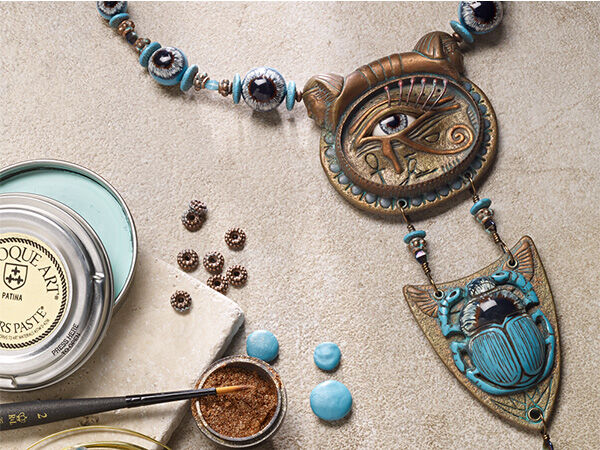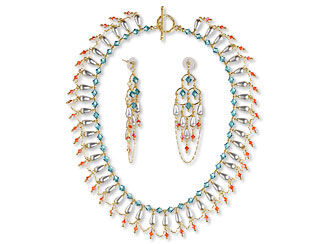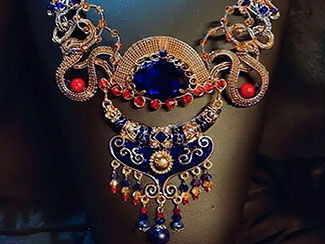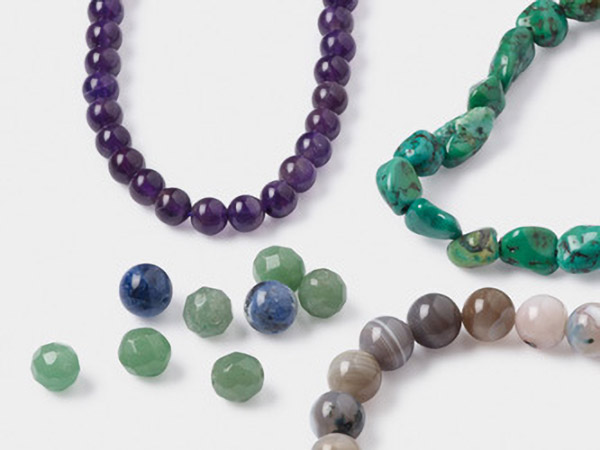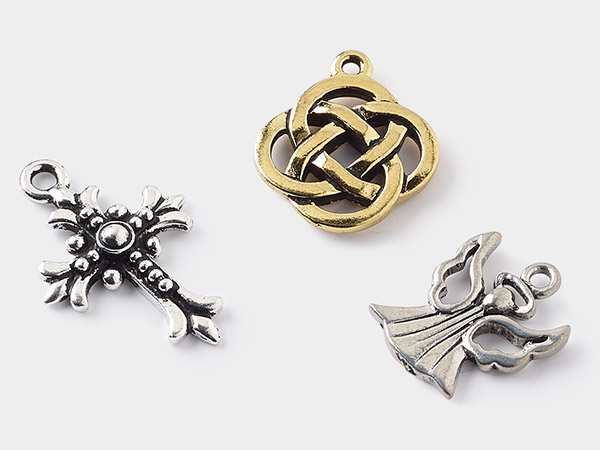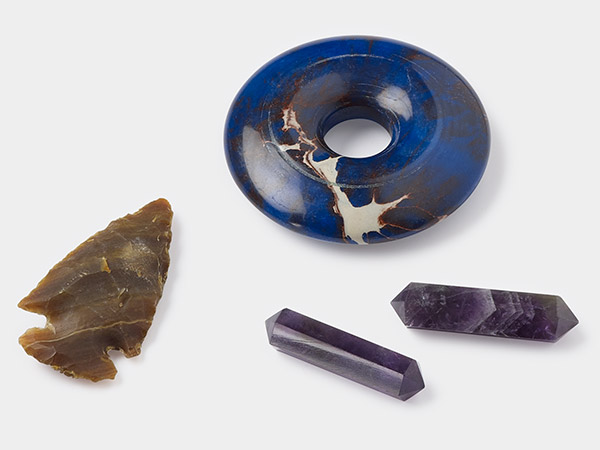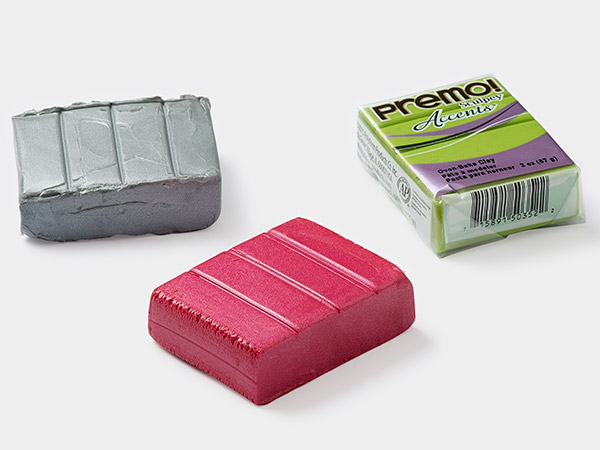Egyptian Jewelry Revisited
For centuries, ancient Egypt has been inspiring archeologists, architects and clothing and jewelry designers with its vividly colored images on tomb walls, monolithic landmarks such as the pyramids and the Sphinx and the dazzling hoards of treasure revealed during archeological digs.
What is the lure of this ancient culture? It could be their prolific use of technology that, even with our modern progress, we still struggle to recreate. The civilization they carved out of the desert beside the Nile River is both beautiful and mystifying. The legacy of ancient Egyptian jewelry tells the story of the culture and the values ancient Egyptians revered.. By learning their languages, reading the meaning in their artifacts, and observing the broad array of extravagant materials collected from their world, we continue to learn about their culture.
The allure of all things Egyptian was kindled by Napoleon's late 18th-century campaign in the region. The pivotal discovery of the Rosetta Stone in 1798, followed by its subsequent translation in the following decades, sparked a growing fascination with ancient Egypt. However, it was the unearthing of Tutankhamun's tomb in 1922 that truly ignited a surge in decorative arts movements inspired by the exquisite designs of ancient Egypt.
Visionary artists like René Lalique and Louis Comfort Tiffany promptly embraced this newfound inspiration, giving rise to a wave of Egypt-inspired creations. The 1920s and 1930s witnessed the dominance of Art Deco, characterized by stunning designs featuring scarabs, hieroglyphs, cartouches, pyramids and motifs like lotus or papyrus stalks. The Egyptian trend resurged when the artifacts from King Tut’s tomb traveled the world in the 1970s and again following several exhibitions in the early twenty-first century.
Today, Jewelry designers are putting their own spin on ancient styles, creating brightly hued bib and pectoral-style necklaces, cuff bracelets, and symbolic charms or pendants—all direct descendants of the ancient culture that inspired them.
Egypt Iconography
The key to translating the influence of ancient Egypt into modern jewelry is to incorporate elements such as relevant symbols, significant gemstones or prominent colors that were common to ancient Egyptians into your designs.
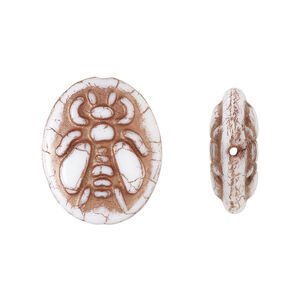
The Scarab
Scarabs are the most common of Egyptian symbols. The scarab, also known as the dung beetle, held a symbolic connection with the Egyptian god of the rising sun. In ancient Egyptian beliefs, it was believed that the scarab, like the god, played a role in guiding the sun along its celestial journey across the sky—paralleling the scarab's action of pushing balls of dung.. As a result, the scarab became a powerful symbol of rebirth and regeneration, leading to the tradition of including scarab amulets within the wrappings of mummies. Later in Egyptian history, scarabs became known as icons of protection and good luck.
Scarabs had twofold symbolism, depending on whether the wings were shown folded or outstretched. Folded wings represent life not yet in existence, and the scarab with wings outstretched depicts personal transformation.
- Shop for scarab beads or fashion your own from precious metal clay
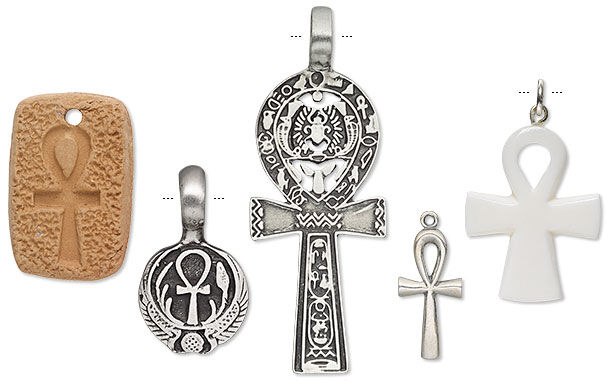
The Ankh
Known as a powerful symbol of life, sometimes referred to as the Key of Life or the Key of the Nile, the looping hieroglyphic cross known as the ankh has been used widely as an affirmation or good luck charm. The ankh can represent more than just life on Earth, also referencing eternal life after death, immortality and reincarnation.
Ancient Egyptians often carried ankhs for protection and incorporated them into religious rituals. Over time, Coptic (Egyptian) Christians embraced the ankh as a symbol of their faith. In a contemporary context, the ankh has become a prominent symbol of African cultural identity, recognized as the most widely known African motif in the Western world.
- Shop for ankh drops and charms or fashion your own from precious metal clay or polymer clay
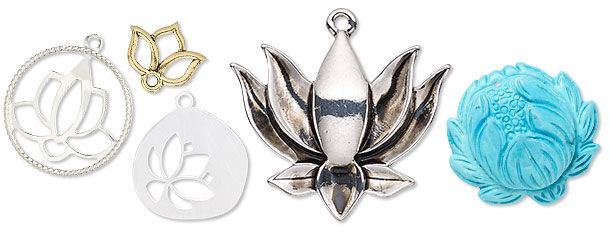
The Lotus
An important Egyptian religious symbol was the lotus, also referred to as the water lily. The lotus has a bloom that closes at night and sinks back beneath the muddy water. In the morning, it re-emerges and blooms. Because of this, the lotus came to represent not only rebirth and regeneration, but purity, as it emerged from the murky water of the Nile as fresh and new as it had been before its descent.
- Shop for lotus drops, focal and charms
Pyramid
Pyramids built by the ancient Egyptians were used as tombs for pharaohs and their queens. The construction of these grandiose structures still baffles modern society. Pyramids were symbols of power and religious dedication.
- Shop for pyramid drops, focal and charms
Egyptian Animals
References to indigenous creatures of the region are often found in jewelry: scorpions, asps, Nile crocodiles, hippos, cats and more.
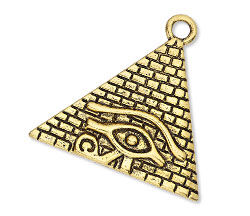
Hieroglyphs
The term "hieroglyph" means "sacred carving" and was coined by the ancient Greeks to describe Egyptian characters. The Egyptian word for hieroglyphs translated to "language of the gods." Egyptian hieroglyphs are either phonograms (glyphs that represent sounds), ideograms (glyphs that represent objects or ideas, also called logograms) or determinatives (symbols that provide clarification about the meaning of a particular symbol). Hieroglyphs served many purposes. They were used to write prayers, magical texts, guides to the afterworld, royal decrees, historical records and mathematical notations. They were also employed as embellishments for jewelry and luxury items. The hieroglyphs were carved into wood, stone or semiprecious gems and cast in gold, silver or other metal. A cartouche, functioning as a king's nameplate, was an oval-shaped design encircling various hieroglyphs.
Egyptian Goddess Isis
While there were many Egyptian deities, Isis is one of the most important goddesses and became a well-known image. Isis was also known as Aset or Eset and was married to the mythical king of Egypt, Osiris. Isis was typically depicted as a beautiful woman in a sheath dress wearing a throne-shaped headdress, although in later iterations, she took on the characteristics of other goddesses as well. Isis was thought to appear in animals forms, and was sometimes represented as a scorpion, cow, bird, sow or as a woman with outstretched wings. Isis was viewed as a goddess of protection for those both alive and dead and was revered for her magical prowess. The worship of Isis was carried on by both the ancient Greeks and the Romans, ending only with the ascent of Christianity in the fourth century C.E.
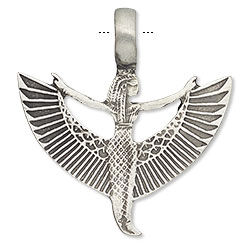
Winged Ma'at
Another important Egyptian goddess who is commonly recognized was Ma'at, or Maat. Ma'at represented balance, truth, justice and divine order. It was believed she set the world in order after its chaotic creation. Ma'at is typically depicted as a woman wearing a crown with an ostrich feather. She could also be seen with an ostrich feather headdress or as a woman with an ostrich feather as her head. She is also occasionally depicted as a winged goddess while holding a specter in one hand and an ankh in the other.
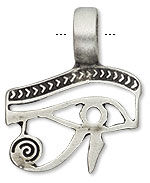
Eye of Horus, Eye of Ra and Wedjat Eye
Wedjat eyes are either left or right. The left eye is associated with Horus and the right eye is associated with Ra. The eye of Horus is a symbol of protection, royal power and health. The eye has six parts, which represent fractions in the Egyptian mathematical system, as well as the six senses and is thought to anatomically correspond to the locations of the sensory regions of the human brain.
- Shop for drops, focal and charms featuring the Eye of Horus
Anubis
The jackal-headed deity of embalming and death was Anubis. Masks of Anubis were often worn by priests during mummification ceremonies. While Anubis was incredibly ancient and important, he was not given temples. Instead, Anubis was associated with tombs and cemeteries. Anubis was guardian of the scales, who would weigh the hearts of man against the feather of truth (ma'at) to determine the fate of individual souls. Anubis was a protector and patron of lost souls and orphans and was associated with rebirth.
Key Materials
Gemstone Beads
The ancient Egyptians adorned their jewelry with a rich array of gemstones, extending beyond the confines of their local resources. While pearls and emeralds were the sole indigenous gems, a treasure trove of precious stones was imported to craft exquisite pieces. Among these, lapis lazuli and turquoise held a special place, their combination of dark blue and light blue shades becoming iconic in Egyptian jewelry. Additionally, the opulent collection featured stones such as carnelian, garnet, black onyx and chrysoprase, a vibrant apple-green chalcedony.
Shop for Your Materials Here:
Have a question regarding this project? Email Customer Service.
Copyright Permissions
All works of authorship (articles, videos, tutorials and other creative works) are from the Fire Mountain Gems and Beads® Collection, and permission to copy is granted for non-commercial educational purposes only. All other reproduction requires written permission. For more information, please email copyrightpermission@firemtn.com.
